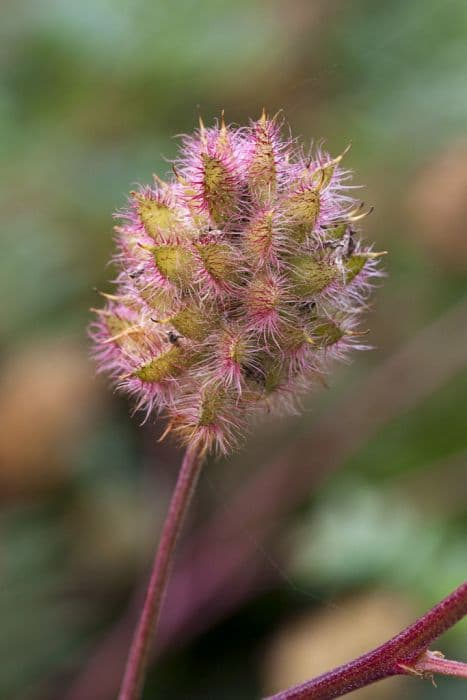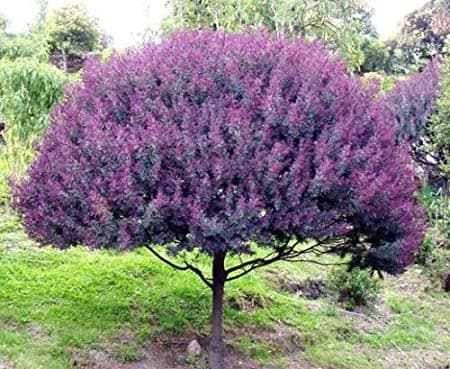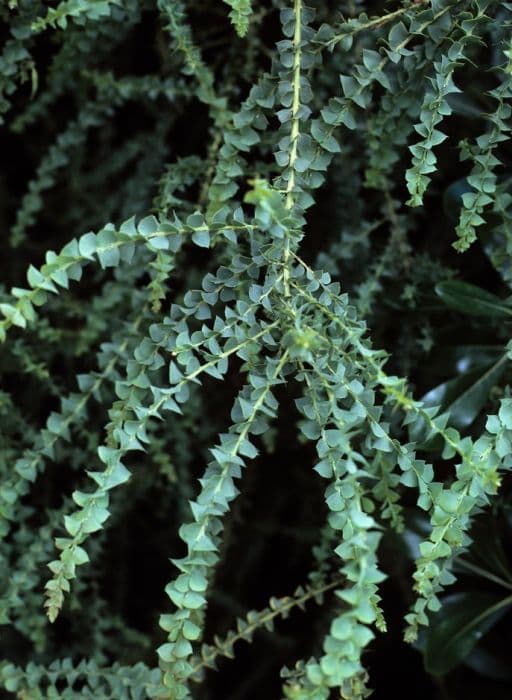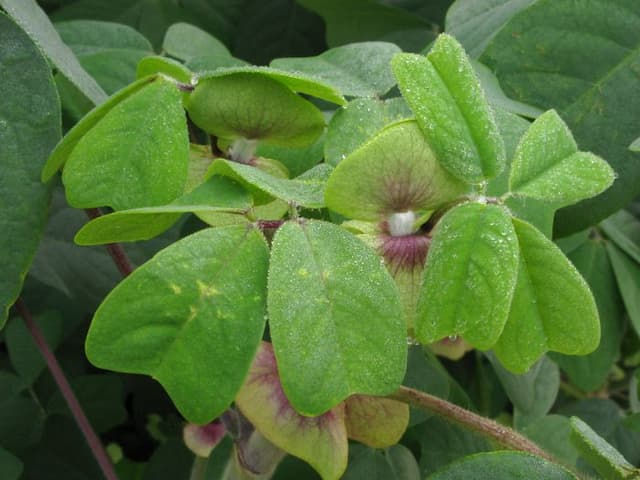Yunnan Licorice Glycyrrhiza yunnanensis

ABOUT
Glycyrrhiza yunnanensis, commonly known as Yunnan licorice, is a perennial herb that showcases a collection of pinnate leaves, which are compound and made up of multiple leaflets. Each leaflet is generally oval to oblong in shape with a pointed tip, possessing a smooth to slightly wrinkled texture, depending on the environmental conditions. The foliage is often a lush green, giving the plant a vibrant vegetative appearance. The Yunnan licorice blooms with small, purplish to pale blue or whitish flowers that are arranged in a distinctive spike-like cluster. These floral spikes can feature numerous individual flowers, with each tiny blossom exhibiting a typical structure that may consist of a banner, wings, and a keel, as seen in many members of its family. The flowers are typically arranged in an aesthetically pleasing, symmetric configuration, making them visually interesting. After pollination, these flowers give way to small, elongated pods containing the seeds. The pods are usually smooth and have a flattened appearance, sometimes exhibiting a slight curvature. When these pods mature, they can vary in color, often turning from green to a brownish hue as they dry and become ready to disperse seeds. Further adding to its character, the Yunnan licorice has a specialized root system that is prized in various cultures for its culinary and medicinal applications. The roots are typically thick and sturdy, and they are known for their sweet taste, from which the common name "licorice" is derived. In summary, the Yunnan licorice presents a pleasing array of green foliage, with brightly colored flowers arranged in clusters, followed by the development of seed pods, and complemented by its significant roots, contributing to both its ornamental and practical value.
About this plant
 Names
NamesFamily
Fabaceae
Synonyms
Yunnan Licorice
Common names
Glycyrrhiza yunnanensis
 Toxicity
ToxicityTo humans
Glycyrrhiza yunnanensis, commonly known as Yunnan licorice, contains a compound called glycyrrhizin which can be toxic to humans if consumed in large quantities. Glycyrrhizin can cause potassium levels in the body to fall, leading to symptoms such as high blood pressure, swelling, lethargy, and could potentially lead to more serious health issues such as heart problems. It's important to consume Yunnan licorice in moderation to avoid these possible toxic effects.
To pets
Yunnan licorice could also be toxic to pets if ingested, as the glycyrrhizin it contains can affect animals in a similar way to humans. High consumption of glycyrrhizin may lead to lowered potassium levels, resulting in symptoms such as increased thirst and urination, high blood pressure, lethargy, and cardiac issues. It is important to prevent pets from consuming Yunnan licorice to avoid these potential health risks.
 Characteristics
CharacteristicsLife cycle
Perennials
Foliage type
Deciduous
Color of leaves
Green
Flower color
Lavender
Height
3 feet (0.91 meters)
Spread
3 feet (0.91 meters)
Plant type
Herb
Hardiness zones
Varies
Native area
China
Benefits
 General Benefits
General Benefits- Traditional Sweetener: Glycyrrhiza yunnanensis, commonly known as "Yunnan licorice," can be used as a natural sweetener as it contains glycyrrhizin, which is much sweeter than sucrose.
- Flavoring Agent: The roots can be used to impart a sweet flavor to foods and beverages, similar to the use of other licorice species in confectionery and tea.
- Gastronomy: In cooking, it can be incorporated into recipes to add a unique aromatic sweetness to dishes and desserts.
- Culinary Diversity: Yunnan licorice can contribute to culinary innovation by offering an alternative to other sweetening agents.
- Gardening and Landscaping: Due to its growth habit, the plant can be used for ornamental purposes in gardens and landscaping projects.
- Erosion Control: It can help in stabilizing soil and controlling erosion due to its extensive root system.
- Nitrogen Fixation: Being a legume, it may contribute to the improvement of soil fertility through nitrogen fixation.
- Biodiversity: It supports ecological balance and biodiversity by providing habitat for various microorganisms and insects.
- Cultural Significance: It has cultural importance in some regions where it may be used in traditional ceremonies or practices.
- Livestock Feed: The plant may also serve as a feed supplement for livestock in some areas due to its nutritional content.
 Medical Properties
Medical Properties- Anti-inflammatory: Glycyrrhiza yunnanensis may have properties that help reduce inflammation.
- Antiviral: It might possess compounds that can combat certain viral infections.
- Immune system modulation: The plant could potentially have effects on the immune system, possibly enhancing its response.
- Hepatoprotective: There could be liver-protecting benefits in this species of Glycyrrhiza.
- Antioxidant: It may contain antioxidants that help in neutralizing free radicals in the body.
- Antimicrobial: Glycyrrhiza yunnanensis could have the ability to inhibit the growth of certain bacteria and fungi.
- Anticancer: Certain components within the plant might exhibit activity against cancer cells.
 Air-purifying Qualities
Air-purifying QualitiesThis plant is not specifically known for air purifying qualities.
 Other Uses
Other Uses- Flavoring agent: Glycyrrhiza yunnanensis root extract can be used as a natural sweetener and flavor enhancer in beverages and candies, similar to its relative Glycyrrhiza glabra.
- Textile industry: The root's extracts may be explored for use in the natural dyeing of fabrics, providing a range of yellow to brown hues depending on the mordants used.
- Gardening: It can serve as an ornamental plant in gardens, particularly appreciated for its attractive flowers and foliage.
- Companion planting: Because of its deep roots, Glycyrrhiza yunnanensis can be planted with shallower-rooted plants to exploit different soil levels and improve land use.
- Soil improvement: The plant has the potential to improve soil structure and fertility through nitrogen fixing, as it belongs to the legume family.
- Cosmetics: The plant's extracts might be used in formulating skin care products due to their potential softening and anti-inflammatory properties.
- Biofuel research: As with other leguminous plants, Glycyrrhiza yunnanensis could be a candidate for bioenergy crop studies, especially in arid and semi-arid regions.
- Wildlife habitat: In its natural habitat, the plant can provide shelter and food for various insects and small animals.
- Ethnobotanical studies: Indigenous people may utilize the plant for various traditional practices, which can be documented for cultural heritage preservation.
- Botanical education: The plant can be utilized in educational settings such as university botanical gardens to demonstrate botanical diversity and plant biology.
Interesting Facts
 Feng Shui
Feng ShuiThe plant Glycyrrhiza yunnanensis, most commonly known as Chinese licorice, is not used in Feng Shui practice.
 Zodiac Sign Compitability
Zodiac Sign CompitabilityChinese licorice is not used in astrology practice.
 Plant Symbolism
Plant Symbolism- Sweetness and Comfort: Coming from the same family as licorice, Glycyrrhiza yunnanensis shares the symbolism of its better-known relative by representing the sweetness in life due to its naturally sweet taste. It is often associated with bringing comfort and relief, much like the sensation of tasting something sweet.
- Healing and Medicine: This plant is used in traditional Chinese medicine. Consequently, it is symbolic of healing and medicinal properties, reflecting the belief that plants can be a source of health and well-being.
- Love and Passion: Licorice has historically been associated with love and passion, possibly due to its sweet flavor being likened to the sweetness of love. This symbolism could extend to Glycyrrhiza yunnanensis as a representation of deep affection.
- Balancing and Harmonizing: In various traditional medical practices, licorice is thought to have properties that can balance and harmonize the body's systems. G. yunnanensis might similarly symbolize the idea of balance and harmony within.
 Water
WaterYunnan Licorice should be watered deeply once or twice a week, allowing the soil to dry out slightly between waterings. Depending on the size of the plant and environmental conditions, you might need approximately 1-2 gallons per watering for a mature plant. Be cautious of over-watering, as Yunnan Licorice does not tolerate soggy soil well. It's beneficial to use a well-draining pot or planting area to avoid standing water which can lead to root rot.
 Light
LightYunnan Licorice thrives best in full sun to partial shade. Ideal conditions involve placing it in a location where it can receive at least 4 to 6 hours of direct sunlight daily, while having some protection from intense midday sun, especially in hotter climates.
 Temperature
TemperatureYunnan Licorice prefers a temperate range between 60°F and 85°F but can tolerate temperatures as low as 50°F and as high as 90°F. Ideal growth occurs when the daytime temperature is consistently within this range. Proper mulching can help to insulate roots from temperature extremes.
 Pruning
PruningYunnan Licorice should be pruned to maintain shape and encourage bushier growth, typically done in late winter or early spring before new growth begins. Pruning can also remove any dead or diseased branches, which will help maintain the health of the plant. Generally, a light trim each year is sufficient.
 Cleaning
CleaningAs needed
 Soil
SoilYunnan licorice requires well-draining soil with organic matter and a pH between 6.0 and 7.5. A mixture of loam, sand, and compost would suit the plant well, ensuring nutrients and proper drainage.
 Repotting
RepottingYunnan licorice should be repotted every 2 to 3 years to refresh the soil and accommodate root growth. Springtime is the ideal period for repotting this plant.
 Humidity & Misting
Humidity & MistingYunnan licorice prefers moderate humidity levels but can adapt to different conditions. Aim for a humidity level around 40-50% for optimal growth.
 Suitable locations
Suitable locationsIndoor
Place Yunnan licorice in bright, indirect light and water when topsoil is dry.
Outdoor
Plant Yunnan licorice in partial shade and protect from extreme temperatures.
Hardiness zone
7-10 USDA
 Life cycle
Life cycleAs a member of the genus Glycyrrhiza, Yunnan liquorice (Glycyrrhiza yunnanensis) starts its life as a seed, typically undergoing a period of dormancy until conditions are favorable for germination. Upon germination, a seedling emerges, establishing a root system and developing its first true leaves. The plant then enters a vegetative growth phase, during which it develops a robust system of roots and shoots, including the characteristic compound leaves of the Glycyrrhiza genus. Following this period of growth, Yunnan liquorice reaches maturity and begins its reproductive phase, producing flowers that are pollinated by insects, leading to the formation of seed-containing pods. Once seeds are mature, they are dispersed by various means, ready to create a new generation of plants. Throughout its life, the plant also invests in the growth and expansion of its underground rhizomes, which can be harvested for their medicinal properties of containing glycyrrhizic acid.
 Propogation
PropogationPropogation time
Spring to Summer
Glycyrrhiza yunnanensis, commonly known as Yunnan Licorice, is generally propagated through the division of roots, a popular method for many perennial plants. This process usually takes place during the plant's dormancy period, which is typically in the late fall or early spring. To propagate Yunnan Licorice by root division, a mature plant is carefully dug up, and the root system is gently separated into smaller sections, ensuring that each section has a portion of the root and some buds or shoots. These sections are then immediately planted at the same depth they were growing before, spacing them about 12 inches (approximately 30 centimeters) apart to allow for ample growth. The soil should be well-drained and fertile, and the new plants must be kept well-watered until they are established.









